
Rare Aviation Books is a specialty bookshop located in Sydney Australia, with a large stock of books, manuscripts, magazines, ephemera and realia relating to the history of flight. The business was founded in 2014 by Professor Marshall Silver, a geotechnical engineer with a lifelong passion for the history of aeronautics. We take some pride in both the rarity and condition of our books and other collectible items.
We are the only antiquarian booksellers in the world with an exclusive focus on aviation, and are well positioned to assist in collection development. Despite the specialised nature of the business, our stock encompasses a diverse range of materials, from children’s books and adventure stories through to technical manuals and engineering resources.
Our shopfront is located in the heart of Sydney at Argyle Place in the historical Rocks district, within easy walking distance of Circular Quay and Wynyard train stations. All visitors are welcome, but we do ask you to ring ahead to ensure the business is attended.
We have several thousand volumes stored offsite in Sydney, and are happy to arrange for inspection of these books prior to purchase. Fresh material is regularly added to our website.
Given the international scope of aviation history, we are proud to stock books in a wide range of languages including French, German, and Italian. Our bookstore manager, Ms. Clotilde Lancereau, is a native French speaker and can actively assist with the acquisition of rare French language books and manuscripts.
Customer satisfaction is our priority, and we are pleased to announce recent membership in the Australian and New Zealand Association of Antiquarian Booksellers.
Rare Aviation Books
Catalogue 3: Spring 2022
Publisher
Rare Aviation Books Pty Ltd 8 Argyle Place Millers Point NSW 2000
Managing Director Prof. Marshall L. Silver
Bookstore Manager Clotilde Lancereau Cataloguing Clotilde Lancereau Hugh Myers Photography Clotilde Lancereau
Design & Layout
Mark Burrough – Burrough Design
1. BLAND, William
The Atmotic Ship.
Sydney: David Mason Printer, circa 1866.
Single printed sheet measuring 570 x 445 mm.
Backed on linen, slight loss of text due to a split at folds (now repaired), otherwise in good condition.
A rare and desirable piece of early Australian aeronautical history, being one of the earliest instances of aviation design published in the colony of New South Wales.
Dr. William Bland (1789-1868) was a surgeon, politician, medical humanitarian, and convicted murderer (following a duel in Bombay in 1813 whilst serving as naval surgeon aboard the Hesper). Tried for murder and found guilty, he was recommended for mercy and transported to Australia for seven years. He went on to practice medicine first in Hobart and later in Sydney.
In 1851, Bland sent technical drawings to England for the first airship designed by an Australian. The drawings represented the Atmotic Ship, taking the shape of a semi-rigid balloon steered by a series of sails. In England, Bland hoped to obtain a patent for his ‘Atmotic Airship’ which would be propelled using ‘steam or perhaps some analogous gas power’.
In 1854, Bland exhibited prototype models of the Atmotic Ship at the Crystal Palace exhibition. With this invention he hoped to revolutionise transport between London and Sydney, and also within the Australian continent. Sadly, the project was never realized due to various challenges in building such a vessel, as well as the danger of using flammable gas for flight.
This fragile broadside, with its four detailed plans, was published about fifteen years after Bland patented his invention. A small number of other publications by Bland relate to his aeronautical aspirations and all are exceedingly rare. Two illustrated booklets from the 1850s demonstrate the evolution of the Atmotic Ship, whose final form is manifest in this broadside of circa 1866. We have only been able to positively ascertain holdings of this broadside in the State Library of NSW and the National Library, indicating the rarity of this item.
$7,500, item #AP2957
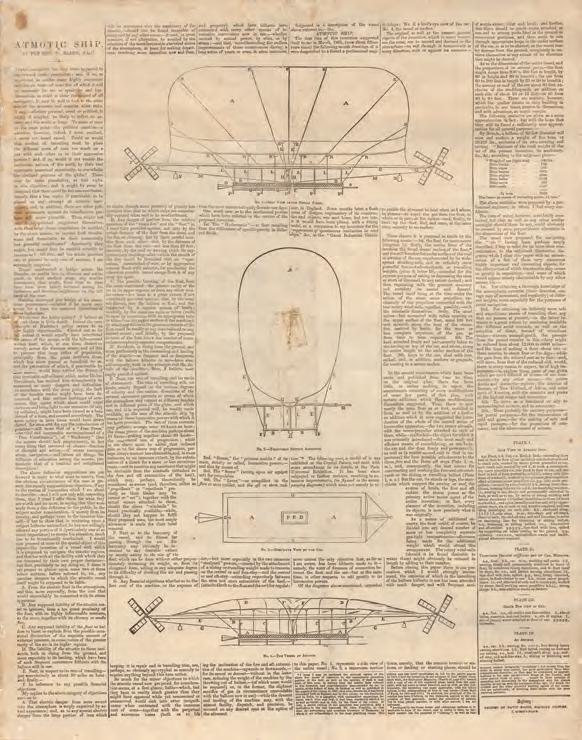
2. BURKE, Keast (editor)
With Horse and Morse in Mesopotamia. The Story of Anzacs in Asia.
Sydney: Arthur McQuitty & Co., 1927. First edition.
Large quarto, original papered boards with blue cloth backstrip, paper spine label and pictorial onlay to the front cover; [viii], 200 pp., including numerous integral photo plates, endpaper maps.

Front external hinge a little frayed but still quite sound, boards a bit rubbed and worn at the corners, light occasional foxing. Overall a very good and handsome copy.
One of the pre-eminent books celebrating the efforts of Australian Army signallers during the First World War in Egypt, the Levant, Iraq and Persia. Lavishly illustrated throughout, it includes anecdote and serious history to form a warm and engaging account of the ANZAC spirit.
$1750, item #AP346
Dornbush 368
3. CASTLE, Irene (Mrs. Vernon Castle) My Husband.
New York: Charles Scribner’s Sons, 1919. First edition.
Octavo, frontispiece, xii, 264 pp., 23 photo plates.
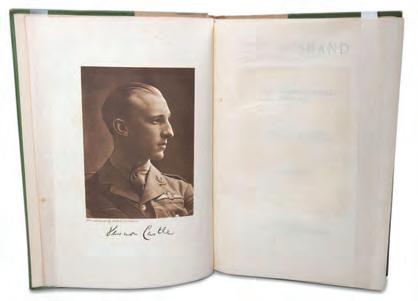
Original quarter cloth in green and beige, spine a bit thumbed and dusted, mild browning; overall, a very good copy.


Biography of the famous dancer written by his wife Irene. The couple were Broadway dancers and actors who reached the peak of their popularity in Irvin Berlin’s first Broadway show, Watch Your Step (1914), in which they refined and popularised the Foxtrot. In 1915, Vernon, born in England, determined to fight in the war and leaving the touring company of Watch Your Step, began flight school in the U.S. He received his pilot’s certificate in early 1916 and sailed for England to enlist as a pilot in the Royal Flying Corps.
Flying over the Western Front, he completed 300 combat missions, shot down two aircraft, and in 1917 was awarded the Croix de Guerre. He was posted to Canada to train new pilots, promoted to captain, and then transferred with his unit to the U.S. as a training pilot. On 15 February 1918, over Benbrook Field near Fort Worth, Texas, Vernon took emergency action shortly after takeoff to avoid collision with another aircraft. His plane stalled, and he was unable to recover control before crashing. He died soon afterwards, aged 30. Irene continued to perform solo in Broadway, vaudeville and motion picture productions over the next decade when she retired from the stage and screen. In 1939, her life with Vernon was dramatized in The Story of Vernon and Irene Castle starring Fred Astaire and Ginger Rodgers.
With the bookplate of Henry W. Shoemaker, a prominent American folklorist. A letter and a Christmas card dated 1920 from Irene Castle to Mrs. Georgia M. Arlei are attached to the rear endpaper in their original envelopes.
$450, item #AP84
Noffsinger 468 (revised edition); Myron Smith 295
4. [De Havilland Aircraft Company]
The de Havilland Gipsy Major Series 10 Operation, maintenance and overhaul handbook.
Hertfordshire: issued by the de Havilland Engine Company Limited, 1948-1957.
Original folder with preliminary leaves and 20 separately paginated sections. A well-preserved maintenance handbook.
This publication comprises 20 sections respectively updated at different times during the timeframe 1948 to 1957. It is complete for the revisions current September 1957. For further information please contact us directly for a full collation report, including the amendment numbers and pagination for each section.
The de Havilland Gipsy Major (or Gipsy IIIA) is a four-cylinder, air-cooled, inverted inline engine used in various light aircraft produced in the thirties, including the famous Tiger Moth biplane. Originally 130 horsepower (92kW), it later developed into 141 and 145 horsepower (105, 110 kW) engines. The Gipsy was one of the most popular sport aircraft engines well into the fifties and was the engine of choice for various light aircraft, trainers, and liaison aeroplanes evidenced by this handbook dating from 1948 to 1957. To the present day, Gipsy Major engines remain in service powering many vintage light aircraft.
Operational handbooks such as this example are rare by their very nature. Composed of replaceable updates, each copy is different and reflects the maintenance history of the workshop where used.

$1500, item #KC1519
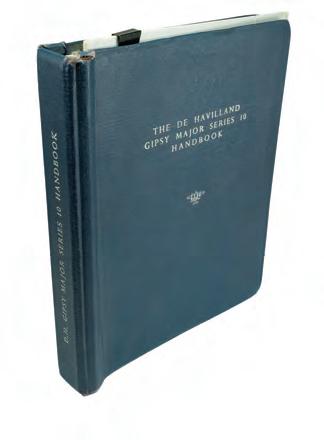
5. FALLS, Cyril, MacMUNN, Lieutenant-General Sir George, and BECKE, Major A. F. (editors)
Military Operations Egypt and Palestine.
London: HMSO, 1928-1930. First edition.
Volume One: From the Outbreak of the War with Germany to June 1917. Volume Two (comprising two volumes): From June 1917 to the End of the War. A set of five parts in total, comprising three text volumes and two bookform map cases. Uniformly bound octavos, original red cloth with gilt spine lettering, some with jackets. The text volumes are profusely illustrated with field sketches, diagrams and photo plates. The first bookform box holds 15 folding maps, the second 23 folding maps. Complete as issued (with the additional folding map in rear sleeve of volume 2, part 1).

One of the text volumes has sustained a localised perforated injury to the back board, another of the text volumes is a little flecked. Overall, the set is in very good condition, with the maps nicely preserved.

An authoritative account of British military operations during the war in Egypt, Palestine and Syria, and of certain operations connected with them. These include the Arab Revolt against the Turks in the Hejaz, the expedition against Darfur, and the Turkish attacks on Aden.
After a deadlock following the Second Battle of Gaza, the British War Cabinet decided upon invading Palestine and dispatched Allenby to succeed General Murray. The first volume is concerned with the defence of Egypt against invasion, with the concentration of the Mediterranean Expeditionary Force in Egypt after the Gallipoli evacuation, advancing to the Turkish frontier, and the expulsion of enemy forces from the Sinai Peninsula. The second volume provides information on largescale operations including the offensive at Gaza and Beersheba, and the subsequent battles in the Judaean Hills for the capture and defence of Jerusalem (from the end of October 1917 to December 1917). It continues with operations in the Jordan Valley in February 1918 until the date of the Armistice.
$1200, item #AP2605
6. [First World War]
Lafayette Escadrille and Flying Corps Address List of Pilots and Relatives


1st February 1928.
Neuilly-sur-Seine: Memorial de L’Escadrille Lafayette, 1928.
Booklet measuring 168 x 238 mm., original printed wrappers, unpaginated but eight leaves in total (including the wrappers).
Leaves detached from original staple binding, paper stock browned, wrappers dusted and chipped with some loss. Overall, the condition is sound but delicate, entirely complete as issued.
A rare and desirable relic of the Lafayette Escadrille, being the only copy we have ever encountered. WorldCat reveals that institutional holdings of the list are slim indeed, with a single copy manifest in the John Winston Graham Aeronautical Collection of the Beinecke Library at Yale.
$1250, item #AP336
Noffsinger 862 and 1688 (revised edition); not in Myron Smith
7. FOKKER, Anthony H. G. & GOULD, Bruce
Flying Dutchman – The Life of Anthony Fokker. New York: Henry Holt and Company, 1931.

Octavo, [viii], 282 pp., frontispiece and 15 photo plates. Quarter crushed crimson morocco with gilt spine ornament, bookplate of Myron Carlson.

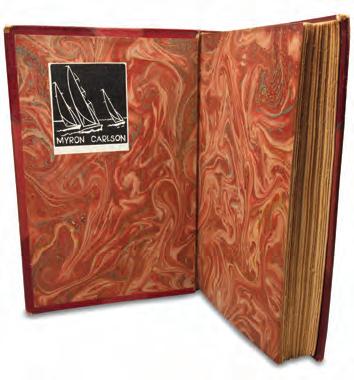

Boards a bit scuffed at the corners, occasional moderate foxing, an attractive copy.
Number 42 in a limited edition of 215 copies; with limitation statement noting ‘of these, none are for sale’.
Anton Herman Gerard ‘Anthony’ Fokker was a Dutch aviation pioneer and aircraft manufacturer. He is famous for the fighter aircraft he produced in Germany during the First World War. The treaty of Versailles forbade Germany to produce airplanes and Fokker moved his aircraft business to the Netherlands. There, his company produced aircraft including the highly successful Fokker Trimotor passenger aircraft. Later biographers suggest he was charismatic but unscrupulous in business.
$1900, item #AP50
Noffsinger 861 (revised edition); not in Myron Smith
8. [GARDINER, Flight Lieutenant C. C.]
Royal Flying Corps. Unique collection of Royal Flying Corps personal training materials from the Ruffy-Baumann aerial training school at Hendon.
London: R.F.C., 1916.
Collection of First World War personal training materials, comprising the following: original ring-bound notebook issued by the Royal Flying Corps with motto and insignia blocked on the front cover. The notebook measures 155 x 225 mm. and contains approximately 100 sheets within card section dividers. In addition to the notebook itself, this collection includes a suite of 15 original photographs from the Ruffy-Baumann aerial training school at Hendon; with manuscript notations to the reverse indicating the identity of the owner (see description below), and dating the training period to December of 1916. Also included are two printed maps, one of the Nancy region of north-eastern France, the other of southern England (counties of Sussex, Kent and Surry).
A remarkable survival from the golden age of the Royal Flying Corps, being the handwritten notebook, personal photographs and maps of Flight-Lieutenant C. C. Gardner during his training at Hendon in late 1916. The notebook is an original R.F.C. issued binder, filled with notes, sketches and diagrams by Flight-Lieutenant Gardner.
The notebook reveals the comprehensive curriculum of pilot training at the height of the First World War. The author’s hand-written notes cover a broad range of subjects commencing with mechanical detail and diagrams of three engine types (Beardmore, Gnome, and Renault), followed by four leaves of original drawings depicting the aeroplanes themselves.
This is followed by detailed notes on rigging and the theory of flight, aerial photography, pressure gauges and mechanisms of regulation, meteorology and barometric prediction, navigation and night flying, wireless communication (with lists of morse code and cyphers), aerial observation related to enemy artillery placements, and sundry other subjects. The notebook is illustrated by Gardner throughout with sketch maps and diagrams including bomb designs, airflow schematics, and myriad mechanical details.
Of particular biographical relevance are the 15 original photographs from Gardner’s training at Hendon, which provide a personal insight into his experience. Of special interest are the smaller format images possibly taken by Gardner himself from the cockpit. A further two of the photographs depict a spectacular crash into a rural barn, and there is one group photograph of the officers of his cohort. The two maps themselves are marked indicative of use for aerial navigation purposes, for example, the map of southern England is marked with R.F.C. airfields, including those in the immediate vicinity of the city of London.
Original First World War training materials of this nature are increasingly uncommon on the market and represent a valuable opportunity for serious militaria collectors.
$1200, item #AP2645
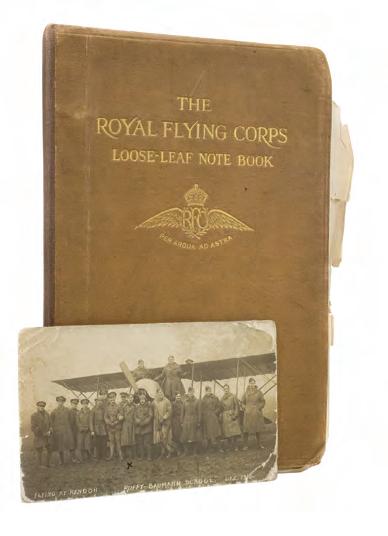


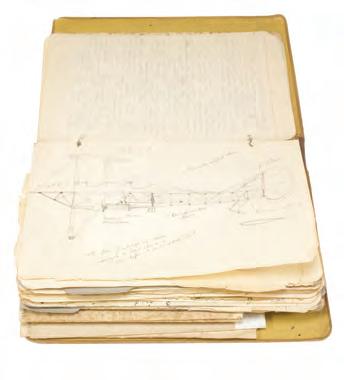
9. FORBES-LEITH, William
The Scots Men-at-Arms and Life-Guards in France. From their formation until their dissolution A.D. MCCCCXVIII – MDCCCXXX.
With etched plates by Major H. de Grandmaison. Edinburgh: William Paterson, 1882.
Two volumes, large quarto. Volume one: [xiv], 10-196 pp., 21 engraved plates and five vignettes (including the frontispiece). Volume two: [x], facsimile muster roll of eight leaves, 232 pp., five engraved plates and four vignettes.
A little rubbed and one corner bumped, yet a beautifully presented set from the library of Sir William Strang Steel, with his bookplates.
Scarce limited edition. This is copy No. 292 of 312, with etchings printed on Holland paper.
The purpose of these volumes is to shed new light on the diplomatic relations and negotiations between Scotland and France from 1418 to 1444, being the last chapter of the Hundred Years’ War. The armed conflicts originated from disputed claims to the French throne between the English House of Plantagenet and the French House of Valois. Over time, the war grew into a broader power struggle involving factions and kingdoms from across Western Europe.

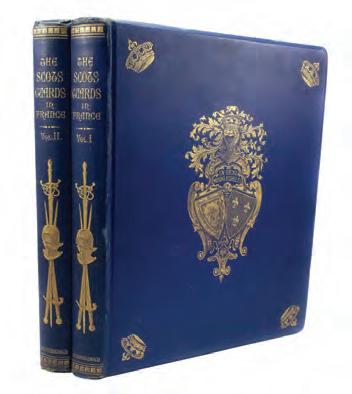
From 1418 onwards, diplomatic negotiations between Scotland and France ended with the landing of Scottish troops in France, among whom were members of powerful Scottish aristocratic families, as shown in the muster rolls reproduced herein.
These two volumes present a history of two Scottish companies: the Scots Men-atArms (1416-1652) and the Scots Life-Guards (1425-1791). They were compiled using records from chronicles and memoirs, state papers and manuscripts in the Public Records Office and in the archives of the Bibliothèque Nationale in Paris.
$650, item #AP156
10. GRAHAME-WHITE, Claude & HARPER, Harry [editors]

The Birthplace of Aerial Power.
London: The Grahame-White Company Limited, 1919.
Quarto, stamped and decorated papered boards with blue cloth on spine, 162 pp., profusely illustrated.

Boards are worn and thumbed, rear inner hinge split but the binding remains tight, otherwise a very good copy.
Claude Graham-White was an English pilot who played a leading role in the early development of British aviation. In early 1910, he obtained the first English aviator’s certificate of proficiency. He entered multiple flying races in Europe and in the United States that same year won the Gordon Bennett Cup. In 1911, he set up the first official English delivery of mail by air. At the outbreak of World War I, he served in the Royal Naval Air Service.
In 1911, he established the Grahame-White Aviation Company at Hendon near London. His company trained many British pilots at Hendon Aerodrome. The firm mostly operated around the design and the building of aircraft, among which was the successful Type XV. In August 1915 he was commissioned to superintend the construction of government planes.
During the First World War, Grahame-White produced the French Morane-Saulnier aircraft types under licence for the British military. In 1920, the company ceased aircraft manufacturing operations and changed its name to the Grahame-White Company Ltd. and began the manufacturing of cyclecars. They would manufacture cyclecars until 1924 when operations ended.
$1250, item #AP2572
New York Public Library 1730; not in Noffsinger and Myron Smith
11. HERVOUIN, René
Guynemer. Héros Légendaire. Douze illustrations de Falcucci.
Paris: Editions Monceau, 1944.
Folio, decorated red cloth case with embossed lettering, 76 pp., vellum filigree paper, profusely illustrated with 14 paintings in colour. Accompanied by the documentation folder containing various photos, letters and mission reports in facsimile. A chronology of Guynemer’s victories (as well as key dates for the history of aeronautics) can be found at the end. A full collation of the contents of the folder is available upon request.
The folding cloth case shows some splitting at the extremities, but the internal contents are in excellent condition.
Guynemer. Héros Légendaire was published in 1944 by Editions Monceau with the patronage of the Aéroclub de France, one of the oldest French organizations for aviators, to celebrate the fiftieth anniversary of Georges Guynemer’s birth (December 24, 1894 – September 11, 1917).
This lavish collection in folio format on filigree vellum is an ode to George Guynemer. It comprises a narrative biography interspersed with documents in facsimile and photographic images.
This work was produced by René Hervouin, a filmmaker, and is embellished with fourteen coloured illustrations. Thirteen of these were created by the French illustrator Robert Falcucci (and not twelve as indicated on the title page).
Guynemer was rejected five times for military service due to frailty, but was accepted for training as a mechanic in late 1914. With perseverance and determination, he joined Escadrille MS.3 (renamed Escadrille N.3 later on) in 1915 and remained in the same unit for the entirety of his service. On September 11th, 1917, Guynemer failed to return from a combat mission and was officially declared missing a fortnight later. With 54 air combat victories, he was considered one of the ace pilots of World War One. Guynemer was awarded the Légion d’honneur, the Croix de Guerre, the Médaille militaire, and the Order of Karadorde’s Star.
1,000 copies published. This copy is No. 167. Foreword letter by General Anthoine.
Guynemer. Héros Légendaire fut publié en 1944 par les éditions Monceau avec le soutien de l’Aéroclub de France, l’une des plus anciennes organisations françaises d’aviateurs, afin de célébrer les cinquante ans de la naissance de Georges Guynemer (24 décembre 1894-11 Septembre 1917).
Ce recueil en format folio sur vélin filigrane est une ode à George Guynemer sous forme de biographie narrative parsemée de documents en fac-similés ainsi que plusieurs reproductions photographiques.
Cet ouvrage réalisé par René Hervouin, cinéaste et documentariste, est agrémenté de quatorze illustrations en couleur, hors-texte, dont treize ont été créées par l’illustrateur français Robert Falcucci et non douze comme indiqué en page de titre.
George Guynemer fut recalé cinq fois du service militaire pour cause de santé fragile mais fut finalement recruté comme mécanicien fin 1914. C’est avec persévérance et détermination qu’il rejoignit l’Escadrille MS.3 (plus tard renommée Escadrille N.3) en 1915 et resta dans la même unité durant toutes ses années de service. Le 11 septembre 1917, Guynemer ne revint pas vivant de sa mission et fut officiellement déclaré disparu le 25 septembre de la même année. Avec 54 victoires dans les airs, il était considéré comme l’un des as de la Première Guerre Mondiale. Il fut décoré de la Légion d’honneur ainsi que de la Croix de Guerre, de la Médaille militaire, et de l’Ordre de l’Étoile de Karageorge.
Edition limitée à 1,000 exemplaires numérotés. Cet exemplaire est le numéro 167. Lettre préface du Général Anthoine.
$400, item #AP2733
Noffinsger F166; not in Myron Smith



12. [John MacGavock Grider] and KNIGHT, Clayton (illustrator)
War Birds. Diary of an unknown aviator. Illustrated by Clayton Knight.
New York: George H. Doran, 1926.
Octavo, black half calf with gilt spine, 282 pp., frontispiece, many illustrations both in colour and black and white.

A beautiful copy.
An unusual large format copy of this classic book, here signed by commanding officers of the Squadron, and recently rebound by a master binder in splendid style.
This special edition was limited to 210 copies autographed by the commanding officers and the artist. This particular instance is the publisher’s file copy, and is marked as such. The signatures include Geoffrey Dwyer, Elliot White Springs, Leslie MacGill, Kenneth Oliver and Clayton Knight.
This copy has two additional large folding plates tipped to the rear endpaper. Although there is no indication that the plates are integral to the book itself, they are nonetheless relevant given their subject matter. One plate depicts British and American cadets at Queens and Christ Colleges, Oxford in October 1917. The second plate is of a cohort of officers attached to the 85th Squadron, R.A.F., at St. Omer, and is dated June 1918.
$1000, item #AP2648
Noffsinger 1207 (revised edition); not in Myron Smith
13. KINGSFORD-SMITH, C. E. [Charles Edward] and ULM, C. T. P. [Charles Thomas Philippe]
Story of the “Southern Cross” Trans-Pacific Flight 1928.

Sydney: Penlington & Somerville, 1928. First Edition.
Small octavo, original blue decorated cloth, 228 pp, with 34 double-sided photo plates.
Some spotting, otherwise a well-preserved copy in dust-jacket (rear panel with small loss).

That memorable feat of flying across the Pacific Ocean from California to Australia is vividly recorded in Story of Southern Cross Trans-pacific Flight, which is illustrated with more than seventy photographs.
Charles Kingsford-Smith and Charles Ulm (along with two Americans – Harry Lyon and James Warner) undertook to cross the Pacific Ocean by air on board a three engine Fokker aeroplane which they named the Southern Cross. Smithy and Ulm complemented each other. Indeed, while Charles Kingsford-Smith was a skilled pilot, Charles Ulm was a great planner and had the ability to raise funds which enabled them to make their transpacific flight a reality. On May 31st, 1928, the four men took off from Oakland airfield in California and journeyed to Brisbane.
Although this book was widely distributed after the Australian landing, copies with the dust-jacket are scarce indeed.
$1500, item #AP3004
14. [LAWRENCE, Colonel T. E.] SHAW, George Bernard
Catalogue of an Exhibition of Paintings, Pastels, Drawings and Woodcuts illustrating Col. T. E. Lawrence’s book “Seven Pillars of Wisdom”. With prefaces by Bernard Shaw and T. E. Lawrence.
London: Ernest Brown & Phillips for Leicester Galleries, 1927.
Small slim staple-bound pamphlet in original printed wrappers, 28 pp. and two photo plates. Wrappers previously split and now expertly repaired with Japanese tissue, externally a little browned, staple lightly rusted and a touch of foxing; overall very good condition.
Third edition of the exhibition catalogue exhibiting the original artworks used in Seven Pillars of Wisdom, the famous autobiography of Lawrence of Arabia. It followed the privately printed first edition of 1926 that was later re-issued by Jonathan Cape for sale to the public in 1935. The pastel portraits of British officers, Arab nobles and Bedouin who fought alongside Lawrence have been long regarded as pre-eminent examples of psychological portraiture.
The catalogue was issued by prestigious London based Leicester gallery, under the auspices of Cecil Phillips and Oliver Brown. The calibre of Leicester Galleries is evidenced by the advertisement on the rear wrapper for previous shows, including painting and sculptures by Van Gogh, Picasso, Matisse, Degas, Gauguin and the like. The present T.E. Lawrence exhibition, of which this catalogue is an extant record, featured original artworks by William Roberts, Eric Kennington, Augustus John, Henry Lamb, Paul Nash, R.M. Young, Cosmo Clark, Colin Gill and Frank Dobson. Two are illustrated in the catalogue with full-page photo plates – namely the famous bust of Lawrence by Kennington, and the pastel portrait of King Feysal by Augustus John. This is the second time the artworks were exhibited, O’Brien noting that this 1927 catalogue was preceded by a Leicester Galleries catalogue of 1921 (being the direct result of Lawrence commissioning Eric Kennington to travel to the Middle East to execute the portraits).
In his celebrated bibliography of Colonel Lawrence, Philip O’Brien notes there are three editions of this catalogue. This is an example of the third and final edition, stated on the front wrapper, and dated February 1927. The third edition of the catalogue is significant because the dagger and headband presented to Lawrence by King Hussein had been added to the exhibition by this stage, and are duly noted in the third edition, with the following explanatory note:
‘The Dagger (Jambyyeh) and Head-band (Agal) were presented to T.E. Lawrence, in 1917, by King Hussein of the Hejaz. Lawrence was requested to wear them as an indication to the Arab Army that he was to be treated and obeyed as though he were a Sherif, but actually, on the field, Lawrence took care that a Sherif by birth should always, though often nominally, be in command. The Dagger was made out of one hundred and fifty gold sovereigns which were melted down for the purpose.’
The introductory text for this exhibition catalogue was provided by George Bernard Shaw, and the text by Colonel Lawrence was lifted from the 1921 commentary on Kennington’s famous sculptured bust.
$1000, item # AP2339
O’Brien T.E. Lawrence, A Bibliography A032 (1921 catalogue); A099

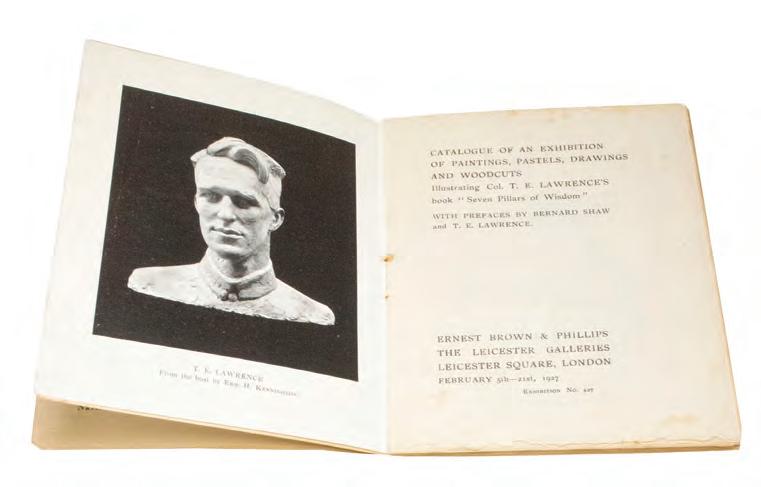
15. “Lieutenant Marc” [VILLARS, Jean Beraud]
Notes d’un pilote disparu (1916-1917).
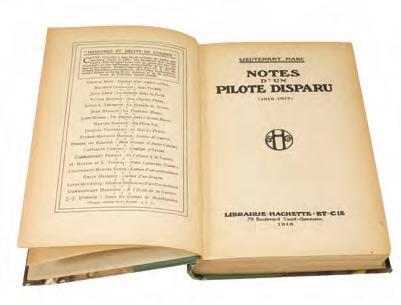


Paris : Hachette, 1918. First edition.
Small octavo, [x], 224, [4] pp., contemporary gilt lettered quarter green cloth. An attractive copy.
Originally published under the nom de guerre ‘Lieutenant Marc’ in 1918, the real author was identified in the 1970’s as Jean Beraud Villars. This book was so critical of the French military and aircraft manufacturers (who he alleged supplied inferior aircraft) that Villars could not publish it under his own name. This is the censored and redacted French first edition. The translated book with notes, complete with the missing text, was published in 1975 by the translators Stanley Pincetl and Ernest Marchand under the title Notes of a Lost Pilot. An important book with an interesting history spanning over fifty years.
$750, item #AP55
16. MASMEJEAN, A. [Auguste]

Les avions allemands.
Paris: Librairie Aéronautique, circa 1916.

Octavo, original beige wrappers with blue lettering, 64 pp. (last blank), six large folding plates.
Wrappers moderately dust-stained and a little chipped at extremities, internally fresh and unmarked, overall a pleasing uncut copy.
Scarce and detailed technical handbook of two German fighter planes (Aviatik and Fokker), prepared for French aviators and mechanics during the First World War. Of special interest are the six perfectly preserved folding plates detailing Mercedes and Oberursel engines. Regarding the Aviatik and Fokker biplanes, Les avions allemands includes two large folding plans showing the front, side and top views, and also the biplane in three dimensional representation.

Auguste Masméjean was born in 1874 at La Cresse in Aveyron, and in 1893 joined the navy. He is listed as principal mechanic (Second class) at the Port of Cherbourg in 1906, and two years later commenced teaching the mechanical sciences as a Professor at Toulon. Expertise in naval engineering broadened in the coming years, and in 1911 he worked specifically on torpedo design and deployment. In late 1913, as First Class mechanic, he was awarded the prestigious Chevalier de la Legion d’Honneur. The demands of the First World War expanded the scope of his work into aviation, of which this book is a result. Masméjean also authored another technical handbook titled Les moteurs à explosion dans l’aviation during the war. Aged 49 years, Masméjean died in Paris late 1923.
$700, item #AP1944
Noffsinger F224; not in Myron Smith
17.
MOREAU-BERILLON, Commandant E.
L’aviation française 1914-1940. Ses escadrilles. Ses insignes.
Paris: Chez l’auteur, 1968.
Eight folders, enclosed in an outer blue folded case, 204 pp., 188 coloured stencil illustration plates.
The outer folder is a little worn and one inner folder shows a few tears on the back, otherwise a beautiful copy.
This work was published in 1968 with the partnership of the Musée de l’air as well as the Association des vieilles tiges and the Association des ailes brisées.
The Musée de l’air, the historical service of the Air Force and the information service of veterans of aviation (in collaboration with Colonel Blech) provided the documentation for this publication on French squadrons and their badges.
This book contains 188 coloured stencil illustrations and highlights the different squadrons and their insignia throughout the history of French military aviation from 1914 to 1940. A table listing the squadrons, their orders of battle and their activities can be found in booklet number eight, Chapter III.
The first part provides general information on French military aviation and more particularly on its development during the Great War, as well as during the years that followed until the beginning of World War Two. There is also a very interesting chapter on naval aeronautics from 1914 to 1940.
The second part offers a historical summary of the war squadrons on the French front from 1914 to 1940.
It is important to note that a mimeographed slip accompanies this folder of eight parts. This errata indicates the errors, corrections, additions and omissions to be found among the eight fascicles contained in the folder (such as the fact that pages 43, 44, and pages from 189 to 192 do not exist!).
Cet ouvrage fut publié en 1968 en partenariat avec le Musée de l’air, l’Association des vieilles tiges et l’Association des ailes brisées.
Le Musée de l’air, le service historique de l’armée de l’air et les renseignements d’anciens de l’aviation en collaboration avec le colonel Blech ont fourni la documentation nécessaire à la rédaction de cette publication sur les escadrilles françaises et leurs insignes.
Cet ouvrage contient 188 illustrations coloriées au pochoir et met en avant les différentes escadrilles et leurs insignes à travers l’histoire de l’aviation militaire française de 1914 à 1940. Un tableau répertoriant les escadrilles, leurs ordres de bataille ainsi que leurs activités peut être trouvé dans le chapitre III du livret numéro huit.
La première partie apporte des informations générales sur l’aviation militaire française et plus particulièrement de son développement au cours de la guerre 19141918, ainsi que pendant les années qui suivirent, jusqu’au début de la Seconde Guerre Mondiale. On trouve également un chapitre très intéressant sur l’aéronautique navale de 1914 à 1940.
La deuxième partie offre quant à elle un abrégé historique des escadrilles de guerre sur le front français de 1914 à 1940.
Il est important de noter qu’un rectificatif accompagne ce dossier en huit parties. Ce rectificatif récapitule les erreurs, corrections, ajouts et manques qui peuvent être trouvés parmi les huit livets que contient le dossier. Par exemple, les pages 43, 44, et 189 à 192 n’existent pas.
$550, item #AP2734
Noffinsger F238; not in Myron Smith


18. MORTANE, Jacques (editor)
La Guerre Aérienne Illustrée du 16 novembre 1916 au 8 novembre 1917.
Paris: L’édition française illustrée, 1916-1917.
Set of two folio volumes comprising the first 52 issues in total. The first part comprises numbers 1 to 24, and is the original gilt illustrated publishers folding case with pictorial onlay, housing the individual issues loosely in wrappers as issued. The second volume comprises numbers 25 to 52 in old blue cloth, with the wrappers bound in at the end.
The loosely issued parts are beautifully preserved, some slightly chipped at extremities (as to be expected from this paper stock); while the second volume is in very good condition.
A substantial run of the copiously illustrated French aviation journal, published during the second half of the First World War.
Jacques Mortane (1883-1939), from his real name Joseph Jacques Philippe Romanet (Mortane being the anagram of Romanet) was a French author and journalist who specialised in aviation. Jacques Mortane began his career as a History Professor before changing career and becoming a sport journalist in 1908 for La vie au grand air. Soon afterwards, he fell in love with aviation and it rapidly became such a passion for him that he abandoned sports journalism to devote his time principally to the developments in aviation.
During the Great War, he published articles on French military aviation in several French newspapers including Le Matin, L’Illustration, Le Journal and La Revue de Paris. In 1916, Jacques Mortane created his own weekly newspaper entitled La guerre aérienne illustrée which, in 1919, would change its name to La vie aérienne.
Gifted journalist and editor, Jacques Mortane became the confidant of many French aces such as Charles Nungesser, René Dorme and even Georges Guynemer whom he had the chance to interview. He published several books dedicated to the aviation aces and contributed to their glorification.
For these services, Jacques Mortane was awarded the Légion d’Honneur. The set comprises two volumes bound in series as per the following collation:
Volume 1 comprises numbers 1 to 24, from 16 November, 1916 to 26 April 1917. Volume 2 comprises numbers 25 to 52, from 3 May 1917 to 8 November 1917.
Une série importante et abondamment illustrée de la revue aéronautique française, publiée pendant la seconde moitié de la Première Guerre mondiale.
Jacques Mortane (1883-1939), de son vrai nom Joseph Jacques Philippe Romanet, Mortane est l’anagramme de Romanet, était un auteur et journaliste français spécialisé dans l’aviation. Jacques Mortane débuta sa carrière comme professeur d’histoire avant de changer de profession et devenir journaliste sportif en 1908 pour le journal La vie au grand air. Peu de temps après, il s’éprit d’une telle passion pour l’aviation qu’il abandonna le journalisme sportif pour se consacrer principalement aux développements de l’aviation.
Pendant la Grande Guerre, il publia des articles sur l’aviation militaire française dans plusieurs journaux français dont Le Matin, L’Illustration, Le Journal et La Revue de Paris. En 1916, Jacques Mortane créa son propre hebdomadaire intitulé La guerre aérienne illustrée qui, en 1919, changea de nom et devint La vie aérienne. Journaliste et éditeur de talent, Jacques Mortane fut le confident de nombreux as français comme Charles Nungesser, René Dorme ou encore Georges Guynemer qu’il eut la chance d’interviewer. Il publia plusieurs livres consacrés aux as de l’aviation et contribua à leur glorification.
Pour ses services, Jacques Mortane fut décoré de la Légion d’Honneur. L’ensemble comprend deux volumes reliés en série selon le classement suivant :
Le tome 1 comprend les numéros 1 à 24, du 16 novembre 1916 au 26 avril 1917. Le tome 2 comprend les numéros 25 à 52, du 3 mai 1917 au 8 novembre 1917.
$650, item #AP2606
Noffsinger F258; not in Myron Smith



19. RALEIGH, Sir Walter and JONES, H. A.
The War in the Air. Being the Story of the Part Played in the Great War by the Royal Air Force.
Oxford: Clarendon Press, 1922-1937.
Complete set of nine volumes, comprising six octavo text volumes, two bookform map cases and final volume of appendices. Numerous maps, plans and charts bound into the text volumes, in addition to the loose maps in the bookform boxes. The first two volumes have their dust-jackets.
Overall an attractive near-fine set with a little usual wear and occasional light flecking. The inner hinge of the sixth volume is split but not detached, and the binding for this volume remains sound. Internally all volumes are fresh and maps nicely preserved.
Complete set of the definitive history of the Royal Flying Corps and Royal Air Force in the First World War.
The ambitious project of documenting and recording the entire history of British military aviation to 1919 was initiated by Professor Walter Alexander Raleigh, a humanist scholar appointed to the Chair of English Literature at Oxford in 1904.
At the outset of the war Raleigh devoted his personal and scholarly energies to the cause, and began compiling this history at the close of the War. As noted in the preface of the second volume, this effort was marred by tragedy: ‘Sir Walter Raleigh, after he had finished correcting the proofs of the first volume, set out on a flying tour of the Middle East. At Mosul he fell sick of a fever and came home to die. The late Dr. D.G. Hogarth was appointed to the task of carrying on the history, but he was compelled, through ill-health and pressure of other work, to give it up.’
And so the monumental task fell upon Henry Albert Jones, who laboured until 1937 when the final volume (with attendant appendices) was published.
Throughout the series, aviation activity is closely overlaid upon strategic army and naval operations, providing a holistic historiographic approach. Fidelity to original sources is maintained throughout, aided by access to official German records in the national Reichsarchiv and Berlin Marinearchiv. The scale and complexity of the cartographic printing that accompanies the set is impressive.
The role of military aviation in peripheral theatres of war is extensively treated in the later volumes, including Italy, Greece and Macedonia, Iraq and the Levant, Palestine, India and Persia. Likewise, naval air operations in the Mediterranean and North Sea are well treated, as is the deployment of aircraft against the U-Boat and submarine menace.
A full collation of all volumes and map cases, along with a detailed condition report, is available upon request. The first set of maps in its bookform box (accompanying the third volume), is complete with all 42 maps. The second set of maps, likewise accompanying the fifth volume, is complete with all 28 maps.
$2500, item #AP2445
Noffsinger 2210; not in Myron Smith
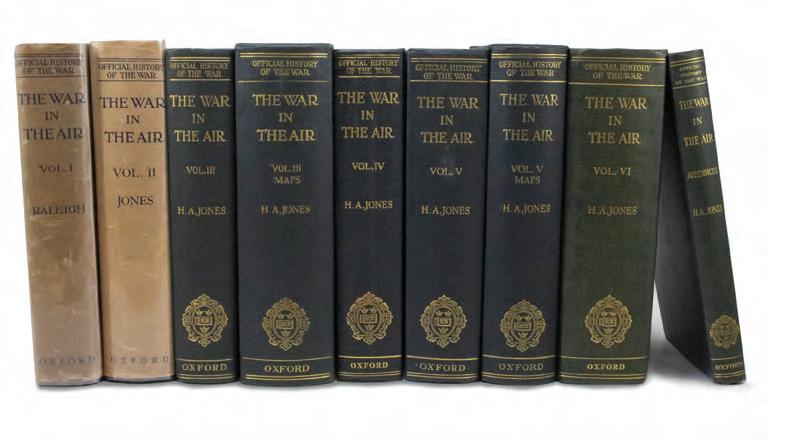


20. [Officer Cadet Battalion]
“Cheerio” Chronicling chiefly Chaps & Chapters of “C” Company No. 2 O.C.B. Emmanuel College, Cambridge December 1917 – April 1918.
Cambridge: W. Heffer and Sons, [1918].
Large quarto measuring 225 x 285 mm., 80 pages of illustrated letterpress, 12 plates (including the portrait frontispiece), two leaves for autographs of members of the Battalion, and ten double-sided advertisement leaves.
Original illustrated wrappers heavily chipped and loose, some foxing, but otherwise in good order and complete.
The Officer Cadet Battalion were formed to address the critical shortage of officers for front-line combat during the First World War, a reflection of the horrific casualty rates of Second Lieutenants who were often first ‘over the top’ in trench warfare.
“C” Company of the Officer Cadet Battalion were housed at Emmanuel College, Cambridge, from 1916 onwards and included a robust mixture of British and Australian officers in training. Some of the rivalry between the two is evident in this magazine, which includes chapters on both Rugby and Aussie Rules Football played at Cambridge, and two full-page photographic plates of the players.
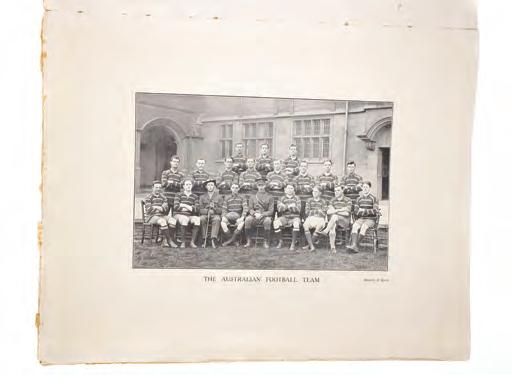
The publisher, Heffer of Cambridge, had previously printed another humorous magazine written by men of the “C” Company of the Officer Cadet Battalion. It is titled ‘A Glad Rag’ and covers the period from late 1916 to March 1917.

Both ‘Cheerio’ and ‘A Glad Rag’ are rare. Despite their importance as a record of the daily life of Australian Officer Cadets in the First World War, we have not been able to locate any copies in Australian Institutional Collections (including the library of the National War Memorial in Canberra).
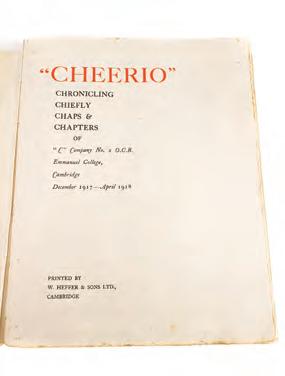
OCLC World Catalogue records a single copy of ‘Cheerio’ in the University Library at Cambridge, and no other locations.
$1200, item #AP239
21. [Royal Air Force]
Original log book of Australian gunner Ronald Williams whilst serving aboard Wellington and Lancaster bombing runs into Germany during 1944.
England: various localities, 1943-1944.
Standard issue R.A.F. gunners log-book with printed cloth covers, well preserved with some recent additional biographical information loosely inserted.
Original flying log book of Warrant Officer Ronald Leslie Williams, a Sydney born gunner who served with RAF Wellington and Lancaster squadrons in many of the significant German raids of March and April 1944.

Ronald Williams was born in Marrickville, Sydney in 1924 and enlisted with the Royal Australian Air Force in early October 1942. This is his personal log book commencing after completion of training at the No. 2 Bombing and Gunnery School at Pt. Pirie South Australia. Williams finished up at Port Pirie in May 1943, and the next entry in his log-book starts in England on 4 September that year.
From September of 1943 to January 1944, he served as a gunner in a Lancaster Squadron, before recording a few Halifax flights through February of 1944. From the entries in this log-book it appears that much of this was preparatory experience for what followed in March and April of 1944.
As a gunner aboard Lancaster bomber 101 Squadron, Warrant Officer Williams participated in some of heaviest runs deep into Germany, including Stuttgart on the 15th of March, Frankfurt on the nights of the 18th and 22nd of March respectively, Berlin on the 24th, Essen on the 26th and Nuremberg on the 30th. These were followed in April by sorties on Cologne, Düsseldorf and Schweinfurt.

Given the high casualty rates for the deep German raids, this log-book is a significant relic; and evidences the close collaboration between the Royal Air Force and Australian airmen such as Warrant Officer Williams.
$1200, item #2944
22. THEILHABER, Dr. Felix A.
Jüdische Flieger im Kriege ein Blatt der Erinnerung.
Berlin: Louis Lamm, 1919.
Octavo, printed wrappers, 52 pp., four plates. Well preserved in the original publisher’s printed wrappers.
Scarce early booklet defending the valour of German-Jewish aviators in the First World War. Printed in 1919, this is the scarce first edition and was followed by an enlarged second edition of 1924.
The author, Felix Aaron Theilhaber (1884-1956), was a physician and gynaecologist based in Berlin and Jena. As a young man he visited Palestine and remained committed to the establishment of a Jewish homeland for the remainder of his life. The squalid and overcrowded conditions of Berlin in the first decade of the century convinced him of the value of social and moral reform. Furthermore, within his role as a physician, Theilhaber was active in the sex reform movement championed by Wilhelm Reich and Max Henkel. He was an early advocate of birth control, legal abortion and resisted the criminalisation of homosexuality under German law.
Theilhaber’s first experience of military life came during the Italo-Turkish war of 1912, whilst volunteering for the Red Crescent in Tripoli. This experience was recorded in his 1912 account titled Beim roten Halbmond vor Tripolis (Cologne, 1912). Theilhaber later enlisted as a frontline field doctor during the First World War, and was conscious of the important part that Jewish soldiers and officers played in the conflict. Much of his non-medical publication record actively resists anti-Semitic attempts to denigrate the Jewish contribution to the German war effort, beginning with Die Juden im Weltkrieg (1916), which was followed by this booklet Jüdische flieger im Kriege (1919). Both were published by Louis Lamm in Berlin, and the latter was republished in 1924.
Jüdische flieger im Kriege is a carefully researched booklet of some 52 pages. It frequently draws upon the authors personal contact with the aviators themselves, or with members of the families of deceased airmen who provided letters and anecdotes. The aviators profiled in this book are: Joseph Zürndörfer, Arthur Chasanowicz, Paul Spiegel, Wilhelm Frankl, Max Holzinger, Ernst Muller, Heinz Bettsak and Max Pappenheimer. All the listed airmen are illustrated with photo portrait plates. Furthermore, the booklet reproduces the Iron Cross award certificates for Ernst Adler and Simon Pinczower, a previously obscure airman from Beuthen in Upper Silesia.
Printed material commemorating the Jewish soldiers, pilots and sailors of the First World War is of enduring historical importance. The contribution of patriotic and valorous Jews to the war effort was an uncomfortable truth for the Third Reich, who attempted to suppress this book in both its editions (and similar publications) throughout the thirties. Ultimately, decorated soldiers and airmen of the First War generation either emigrated or perished in the camps, as nothing less than personal intervention by a General appealing to the Nazi executive could save them. As for Theilhaber himself, following a few months of imprisonment by the Gestapo in 1933, he ultimately emigrated to Palestine and continued to practice medicine into the fifties. His brother, a Berlin based lawyer named Robert Theilhaber, was murdered in Auschwitz in 1942.
$725, item #AP2440
Noffsinger G572; not in Myron Smith


23. [Royal Australian Air Force]
Flying Log Book. Sir John Kerr AK, GCMG, GCVO, K ST J. QC No. 34

Squadron Royal Australian Air Force 10 July 1974 to 7 December 1977.
Sydney and Canberra: compiled by officers of the 34 Squadron, 1974-1977.
Hardcover booklet measuring 195 x 223 mm., with a total of 45 double-sided leaves. Excellent condition.
This log book records the entire flight history of Sir John Kerr while acting Governor General of Australia.
Details of all flights are tabulated, including the aircraft type, identity and rank of the aircraft Captain on duty, route, distance and elapsed time. A running total indicates Sir John Kerr was airborne for 582 daylight and 46 night-time hours during his term of service.
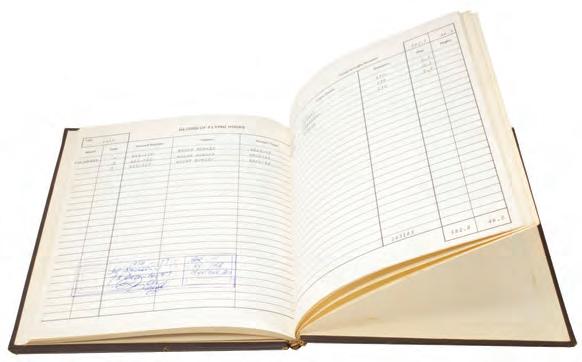
The log book records the flights immediately relevant to the famous, and politically unprecedented, removal of Prime Minister Gough Whitlam from Office; including the meeting with Chief Justice Garfield Barwick on the ninth of November 1975, the flight to Canberra on the following day, which was followed by the dismissal on the eleventh of November.
This specially bound copy was presented to Sir John Kerr upon retirement by officers of 34 Squadron, and has a titling leaf bound in stating such.
$1500, item #AP1967
24. [United States Army]
Summary of Intelligence Second section, General Staff. General Headquarters American Expeditionary Forces.
France: Published by the Office of the American Expeditionary Forces, 1919.
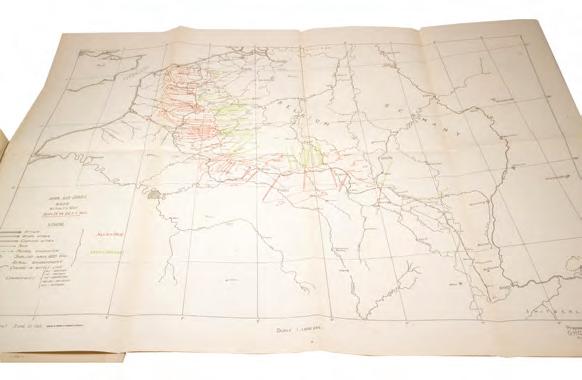
Seven volumes, folio, each in original printed wrappers. Bound into this impressive set are several lithographic plates and numerous large folding maps prepared by the U.S. Army 29th Engineers.

A well-preserved set from the Hoover Library, with duplicate stamps to the front covers. Also bearing the old ownership signature of Lt.-Colonel R.H. Williams.
Numbers 1 to 286 of field military intelligence reports prepared during the first war, here printed collectively towards the close of the hostilities (or shortly afterwards), and arranged with continuous pagination. The reports cover the date range from January to November 1918.
Also bearing the old ownership signature of Lt.-Colonel R.H. Williams.
$2500, item #AP158
25. WILKIE, Major A. H.
Official War History of the Wellington Mounted Rifles Regiment 1914-1919.

Auckland: Whitcombe & Tombs, 1924.
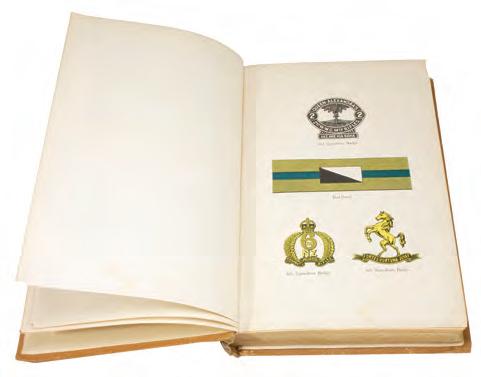
Octavo, original lettered brown cloth, [xvi], 260 pp., 18 double sided photo plates, 22 maps (many folding, including the large map of Palestine bound at the rear). Additional to the listed plates is a colour plate of the insignia of 2, 6, and 9 Squadron and the Hat-Band.
Touch of flecking affects the cloth, spine ends a bit rubbed, but a handsome copy overall, internally excellent.
One of the great New Zealand regimental histories of the First World War, remarkable for its comprehensive series of photographic plates detailing many aspects of the Gallipoli campaign, and the excellent maps. Fittingly, the book is prefaced by the famous poem of Rupert Brooke, another Gallipoli casualty, titled ‘Dedicated to the Memory of the Fallen who Died that we Might Live’.
Iconic Gallipoli images include a battlefield on Armistice Day, the beach landing, two images of Walker’s Ridge, a view from the heights into Sulva Bay, the famous periscopic riflemen, Destroyer Ridge, Big Table Top, Camel’s Hump, and so forth. Likewise, the maps have been carefully prepared and include detailed small-scale battle plans, through to entire operational campaigns. For example, the map of Hill 60 details both Ghurkas and New Zealand infantry.
Aside from extensive fighting on the Gallipoli Peninsula, the Wellington Mounted Rifles fought in Egypt (Romani, Bir El Abd, Katia), and Palestine (Gaza, Beersheba, Ras El Nagh, Jaffa, Jerusalem) and the Jordan Valley.
$650, item #AP2347
Rare Aviation Books
8 Argyle Place
Millers Point, NSW 2000 Australia
Phone: (02) 9241 2232
Mobile: 0499 797 009 www.rareaviationbooks.com
Open Monday to Friday 10:00 am to 5:00 pm
Please call ahead of time
Shop and Payment details
For purchasing and enquiries please contact Clotilde Lancereau at cloe@rareaviationbooks.com.
Payment by credit card or bank transfer using the details below (using invoice number as your deposit reference):
Bank name: ANZ – The Australia and New Zealand Banking Group Limited
Bank address: 242 Pitt Street, Sydney NSW 2000, Australia
Swift Code: ANZBAU3M
Account name: Rare Aviation Books
BSB: 012-013
Account No.: 1948-21762
All material guaranteed as described, returns cheerfully accepted (including postage charges) on reasonable grounds.
Barangaroo Reserve
Walsh Bay Rare Aviation Books

Sydney Observatory
The Rocks
Sydney Opera House
Circular Quay

